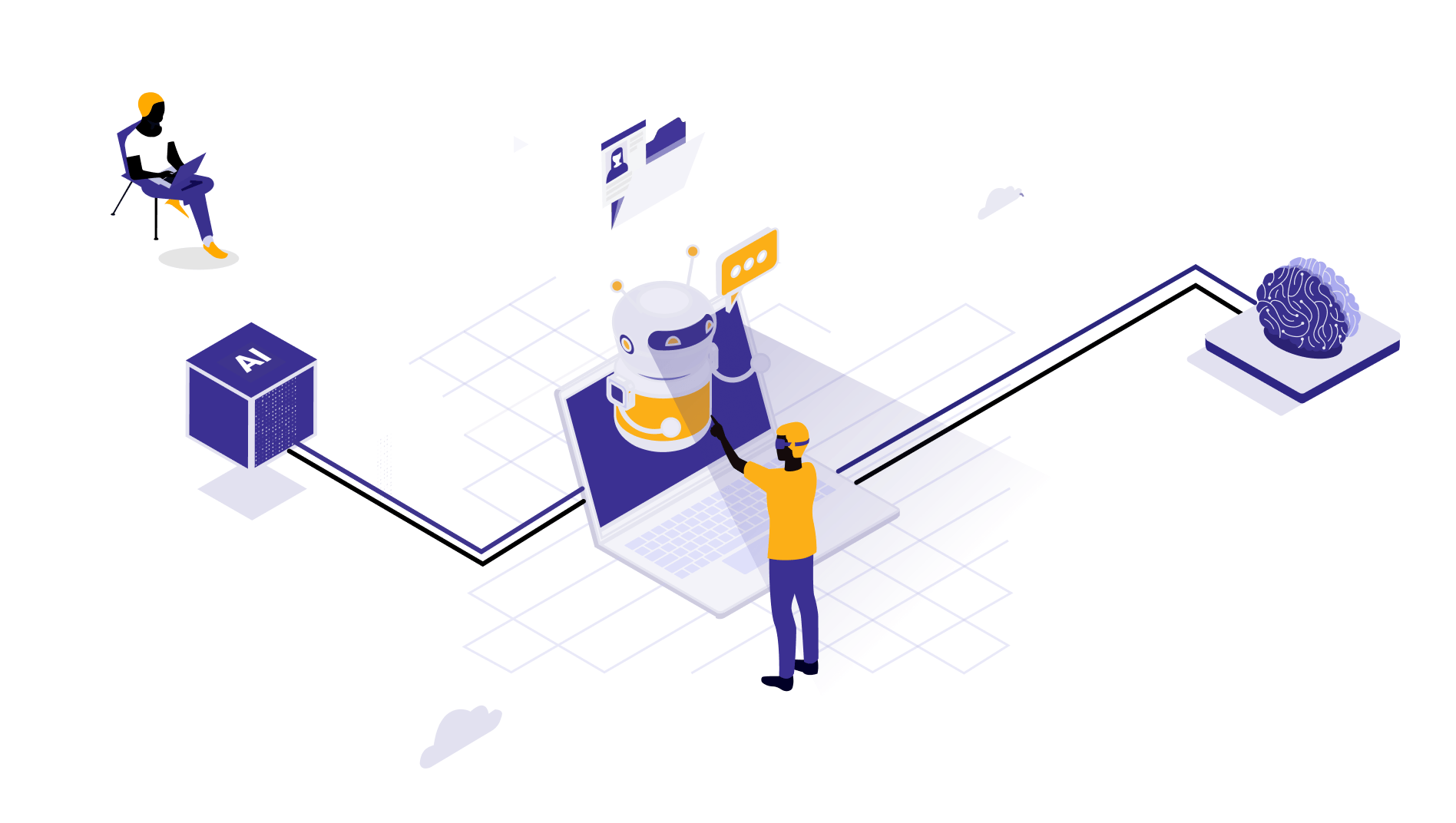Deep learning vs machine learning: Key differences
This article is all about breaking down the concept of deep learning vs traditional machine learning, how they work, their use cases, etc—with fewer jargons around.

Thulasi
Dec 4, 2025 |
6 mins

Introduction
Concepts like machine learning and deep learning are gaining momentum. Organizations and their leaders are trying to wrap their head around, expanding their interests and investments in these advanced solutions.
But, it all starts with understanding how they work at the core level. That’s how you can tell which is applicable for what use case, maximizing the results in one go.
Dive right in to understand their differences, so as to leverage their offerings to improve your business. Treat this article like an up-to-date guide on effective AI algorithms and AI-based decision making for your business.
Machine learning vs. deep learning - What you should know?
Let’s get the basics right before we explore the differences and find ways it can impact your business.
Here is a quick overview of both:
Machine learning
You show an apple to a child and say apple. The child traces its shape and learns that it’s an apple, will squeal apple everytime it spots one. That’s one way to put how machine learning works. It’s a subset of AI—allows computer systems to learn—and make decisions from large, structured data sets without being explicitly programmed. Like a child’s brain, ML continually tracing patterns in the data it is trained on with the help of complex algorithms. That’s how it identifies the logic behind a problem, and makes correct predictions for a new set of data.
In the real world, you could notice businesses using machine learning in multiple avenues. Machine learning could solve problems like uncovering complex insights to generating business predictions to performing functions such as Business Process Automation and more. Examples: machine learning in forecasting, etc...
Deep learning
At the outset, here's something you've got to know—Deep learning is in fact a type of machine learning. Deep learning is built inspired by the structure and function of our very own brains.
Imagine showing the same child apples, oranges, pears, and many similar objects, teaching and training to say the right answer. And the child does, comparing the intricate patterns, shapes, colors, and other differentiating factors. That’s how deep learning works.
Deep learning algorithms use multi-layered "neural networks" that analyze vast amounts of data to identify patterns and make predictions. With deep learning, we allow machines to learn and improve automatically by processing and analyzing large amounts of data. Deep learning has its special neural networks to predict if the decision is accurate or not.
Deep learning is solving complex problems like powering self-driving cars to image recognitions to advanced medical systems in healthcare, dominating many industries. Or helps us find contextual answers to questions in natural languages like how long does Whisper take to transcribe.
Difference between machine learning and deep learning
The difference between machine learning and deep learning is that machine learning may require human intervention to learn or make decisions, but deep learning doesn’t. Machine learning addresses mid to complex-level problems while deep learning is for complex problems.
We made a table with pointers that explain detailed differences between machine learning from deep learning along with common deep learning and machine learning solutions.
Point of comparison | Deep learning | Machine learning |
What is it? | Subset of ML, modeled on the human brain, to solve AI problems. | Subset of AI, learns by tracing patterns in user-fed data to make decisions. |
What does it need? | Data, massive amounts of them—labeled and/or unlabelled—from one or multiple sources. | Traditional machine learning algorithms work on much smaller datasets—structured. Unstructured data calls for human intervention to perform feature engineering so that it can learn and function again. |
Does it need human intervention? | No human intervention NEEDED to supervise the learning process. Deep learning systems learn from large volumes of data all by themselves. | Needs a data scientist or data science team to train and monitor the process. |
What kind of hardware support do they need? | Need more time, resources, and advanced hardware to make deep learning function. | Uses low-end hardware; Thus, much faster comparatively. |
How fast and efficient? | Large amounts of data is fed to get highly effective output—meaning the process will slow. | Easier to set up and faster to train. However, not as efficient as deep learning in terms of output capabilities. |
How much data can they handle? | Can handle large datasets, even millions in volume. | Works better with smaller datasets, with rows in thousands. |
Name a few examples | Autonomous vehicles, NLP functions for virtual assistants, addition of sounds to silent films, and more. | Demand forecasting, product recommendation, fraud detection, etc. |
How does deep learning work?
Here is how a deep learning system works.
Fundamentally, deep learning is a subset of machine learning, both uses complex algorithms to parse data. However, a deep learning system does not learn from a structured data set with a set of distinguishable "features".
Bringing the apple, oranges, and pears reference again. As deep learning relies on its neural network, it does the learning on its own without expecting humans to point out this is apple and this is orange. Or without a human feeding its features, colors, and appearances.
Here is what happens on the backend. Deep learning systems have neural networks made up of layers— interconnected nodes that process data. Each layer takes input from the previous layer and applies an algorithm to transform it into an output (also called activation function).
The outputs of these layers are then fed into another set of neurons in another layer until we reach the final output layer. This output layer finally gives us the output data.
Here’s a similar deep learning system distinguishing between lemons and oranges.
No one is training it on different types of fruits nor do they feed instructions.
Through its neural network, it automatically identifies the features of the fruits and performs the classification. On top of that, it predicts the accuracy behind its prediction too, all through the power of its neural network.
Examples of deep learning
Thanks to its powerful predictive capabilities, deep learning has seen a surging popularity—finding its niche across multiple industries.
Virtual assistants
Have you noticed chatbots like ChatGPT mimicking human interactions? Many organizations are making use and setting up all-around, all-rounder virtual assistants and enhancing customer relationships.
Deep learning is the king here aiding the assistants with natural language processing capabilities—so much so that the interactions feel human-like.
Facial recognition
Deep learning can assess a vast dataset of human faces, their expressions included. This can be leveraged to accurately identify who they are and mark their presences, if needed.
Thus, they are heavily employed systems capturing faces - anything from attendance systems to airport security systems, with improved accuracy and incredible reliability.
Speech recognition
Speech recognition applications like Amazon’s Alexa use ML for their functioning, converting spoken word to text. They do so by creating measurements of words using a set of numbers which represent the speech signal.
Healthcare and pharmaceuticals
Deep learning is transforming the healthcare industry and lives dependent on it. From detecting life-threatening diseases to improving drug discovery efforts, etc., with the help from medical imaging systems.
Security and fraud detection
With fraud becoming more common and spanning across industries, deep learning systems can play a pivotal role curbing them. Industries like banking, real estate, insurance etc can employ systems powered by predictive learning.
By doing so, they can identify and prevent prospective fraud occurrences—through predictive analysis which helps finding future trends from data.
How does machine learning work?
Let's explore how to build ML model first to learn how it works. To begin with, we feed the "training data" to the machine, a set of inputs and their corresponding outputs.
To begin with, we feed the "training data" to the machine, a set of inputs and their corresponding outputs. By continuously learning through the training data, the machine develops a predictive model that has identified the "logic".
It interprets this logic by studying the input-output relationships in the training data, and improves it with every iteration. This learning is often supervised by a human, interrupting then and there.
Now, you are subjecting the model to a fresh set of test data. The model makes its predictions based on its training, which is used to evaluate the accuracy of the predictions.
We will go by the same example used earlier: The machine learning system has to identify lemons and oranges. So, we feed the features of both to the ML algorithm—the color, weight, texture, etc. As it’s trained scores of such examples, it identifies correctly and classifies the category in which the new item falls under.
Examples of machine learning
Like deep learning, machine learning can be found across various industries too. Some of its applications:
Product recommender
Many popular ecommerce platforms use ML to recommend products that their customers would prefer purchasing, by assessing purchase history, search patterns, cart history, etc.
Social media
Many popular social media platforms use ML for image recognition—to connect you with people and profiles sharing similar connections. It makes note of your engagement on their platform–likes, follows, reactions, and everything and suggests similar things.
Transportation
Commute apps like Uber use machine learning to provide travel options and recommendations, accurately. Putting together your location and travel history, these apps provide recommendations to places you are more likely to visit.
Spam detection
Compare the new email content and its metadata with previously flagged email—exactly how ML algorithms work to filter out spam messages from real ones.
This isn’t the end, clearly for both machine learning and deep learning. More use cases uncovered everyday—where ML or deep learning can make a difference.
Does deep learning replace machine learning?
With more businesses exploring and employing machine learning and deep learning applications, the question remains—Will deep learning fully take over ML with its capabilities?
To answer the question—not fully so, yet.
While deep learning has proven to be highly effective and powerful, with more advanced capabilities than ML, it does not provide us with tangible methods of understanding and diagnosing its predictions like ML does.
Many verticals such as aviation, customer service and advertising still rely on ML due to the sheer reliability it comes with.
When to use machine learning and when to use deep learning totally depends on the size and richness of your data and the complexity of business requirements.
Have unique problems where machine learning or deep learning could be of help? Looking for how to create an ai strategy for your company, Need an expert hand in shuffling through the various ML and deep learning solutions, picking the best and implementing it real-time?
Contact our experts at datakulture, harness the power of advanced technology today, and chart your way to growth. With a team that truly works like your business’s extension, you will have a model in place that addresses the problem and boosts your business growth.
Build smarter, scalable models with our AI & ML development services.

by Thulasi
A senior data scientist, head of the data science team, and IIT alumni – Thulasi enjoys working around machine learning models - ‘using historical pattern, customer needs, right amount of ML masala and inspiration to deliver a delicious ’meal’, as he calls it.



